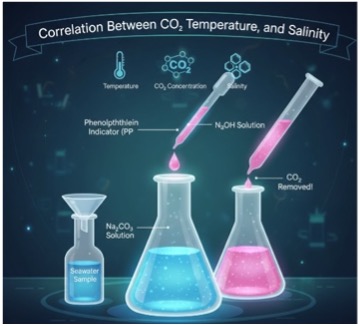Correlation Between CO₂, Temperature and Salinity
Main Article Content
Abstract
An experiment entitled “The Corellation Between CO₂, Temperature, and Salinity” was conducted to determine the interrelationship among carbon dioxide concentration (CO₂), temperature, and salinity in seawater. The instruments used in this experiment included an Erlenmeyer flask, volumetric flask, drop pipette, funnel, and sample bottle. The materials used were seawater, phenolphthalein indicator (PP), sodium hydroxide (NaOH), and sodium carbonate (Na₂CO₃). The method applied in this experiment was titration using NaOH solution. The results showed that the seawater sample tested positive for the presence of CO₂, as indicated by no color change after the addition of the phenolphthalein indicator. The removal of CO₂ from the sample was observed when the solution turned pink after titration with NaOH, confirming the success of the experiment.
Article Details

This work is licensed under a Creative Commons Attribution 4.0 International License.
References
1. Krishnaveni, B.; Shailaja, K.; Chapla, J. Water quality assessment of Bibinagar Lake by physico-chemical parameters. ER 2024, 6(1), 1–9.
2. Tseng, C.; Tinoco, R. From substrate to surface: A turbulence‐based model for gas transfer across sediment‐water‐air interfaces in vegetated streams. Water Resour. Res. 2021, 58(1).
3. Edori, E.; Edori, O.; Nwoke, I. Degradability and organic strength of gross organic pollutants in surface water of Mini Whuo Stream, Rivers State, Nigeria. J. Phys. Sci. Environ. Stud. 2022, 8(2), 15–20.
4. Sawanaka, Y.; Torii, J.; Tachibana, Y.; Kasuya, K. Feasible analytical protocol of residual polymers in culture medium after biodegradation testing. Preprint 2025.
5. Anggrahini, S.; Fadlillah, L. Analysis of the total maximum daily load of the Buntung River in Ngaglik District, Sleman Regency. IOP Conf. Ser. Earth Environ. Sci. 2025, 1443(1), 012027.
6. Wang, L.; Lv, H.; Yang, Q.; Chen, Y.; Wei, J.; Chen, Y.; Jia, J. A universal biofilm reactor sensor for the determination of biochemical oxygen demand of different water areas. Molecules 2022, 27(15), 5046.
7. Hryha, M. Spatiotemporal variation evaluation of biochemical oxygen demand (BOD) in Dnipro River. Hydrol. Hydrochem. Hydroecol. 2024, (2)(72), 29–41.
8. Abagale, F. Seasonal variation and removal of organic pollutants in wastewater using low-cost treatment technologies in Tamale Metropolis, Ghana. J. Water Resour. Prot. 2021, 13(4), 271–282.
9. Aguilar-Torrejón, J.; Balderas‐Hernández, P.; Roa-Morales, G.; Barrera-Díaz, C.; Rodríguez, I.; Torres-Blancas, T. Relationship, importance, and development of analytical techniques: COD, BOD, and TOC in water—An overview through time. SN Appl. Sci. 2023, 5(4).
10. Dhinesh, R.; Aruna, S.; Manikandavelu, D.; Ravaneswaran, K.; Kirthiga, S.; Al‐Ghanim, K.; Kamaraj, C. Naturally derived organic biochar as an alternative to commercially activated carbon in the oxygen removal of seafood processing wastewater. J. Chem. Technol. Biotechnol. 2024, 99(7), 1691–1702.
11. Duque, G.; Gamboa-García, D.; Molina, A.; Cogua, P. Effect of water quality variation on fish assemblages in an anthropogenically impacted tropical estuary, Colombian Pacific. Environ. Sci. Pollut. Res. 2020, 27(20), 25740–25753.
12. Fitri, A.; Maulud, K.; Pratiwi, D.; Phelia, A.; Rossi, F.; Zuhairi, N. Trend of water quality status in Kelantan River downstream, Peninsular Malaysia. J. Rekay. Sipil (JRS-Unand) 2020, 16(3), 178.

